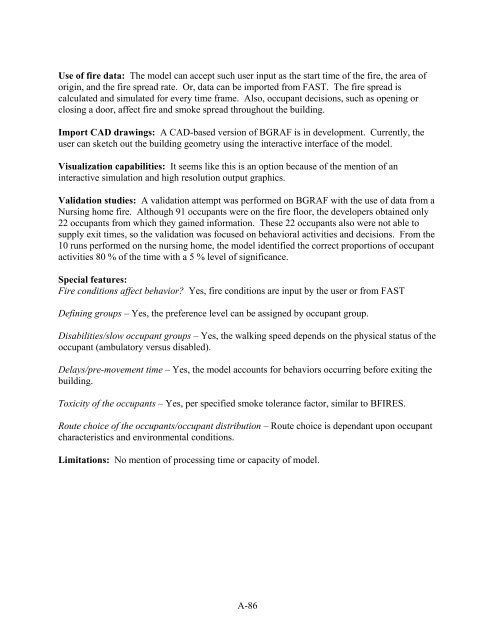A Review of Building Evacuation Models - NIST Virtual Library
A Review of Building Evacuation Models - NIST Virtual Library
A Review of Building Evacuation Models - NIST Virtual Library
Create successful ePaper yourself
Turn your PDF publications into a flip-book with our unique Google optimized e-Paper software.
Use <strong>of</strong> fire data: The model can accept such user input as the start time <strong>of</strong> the fire, the area <strong>of</strong><br />
origin, and the fire spread rate. Or, data can be imported from FAST. The fire spread is<br />
calculated and simulated for every time frame. Also, occupant decisions, such as opening or<br />
closing a door, affect fire and smoke spread throughout the building.<br />
Import CAD drawings: A CAD-based version <strong>of</strong> BGRAF is in development. Currently, the<br />
user can sketch out the building geometry using the interactive interface <strong>of</strong> the model.<br />
Visualization capabilities: It seems like this is an option because <strong>of</strong> the mention <strong>of</strong> an<br />
interactive simulation and high resolution output graphics.<br />
Validation studies: A validation attempt was performed on BGRAF with the use <strong>of</strong> data from a<br />
Nursing home fire. Although 91 occupants were on the fire floor, the developers obtained only<br />
22 occupants from which they gained information. These 22 occupants also were not able to<br />
supply exit times, so the validation was focused on behavioral activities and decisions. From the<br />
10 runs performed on the nursing home, the model identified the correct proportions <strong>of</strong> occupant<br />
activities 80 % <strong>of</strong> the time with a 5 % level <strong>of</strong> significance.<br />
Special features:<br />
Fire conditions affect behavior Yes, fire conditions are input by the user or from FAST<br />
Defining groups – Yes, the preference level can be assigned by occupant group.<br />
Disabilities/slow occupant groups – Yes, the walking speed depends on the physical status <strong>of</strong> the<br />
occupant (ambulatory versus disabled).<br />
Delays/pre-movement time – Yes, the model accounts for behaviors occurring before exiting the<br />
building.<br />
Toxicity <strong>of</strong> the occupants – Yes, per specified smoke tolerance factor, similar to BFIRES.<br />
Route choice <strong>of</strong> the occupants/occupant distribution – Route choice is dependant upon occupant<br />
characteristics and environmental conditions.<br />
Limitations: No mention <strong>of</strong> processing time or capacity <strong>of</strong> model.<br />
A-86
















